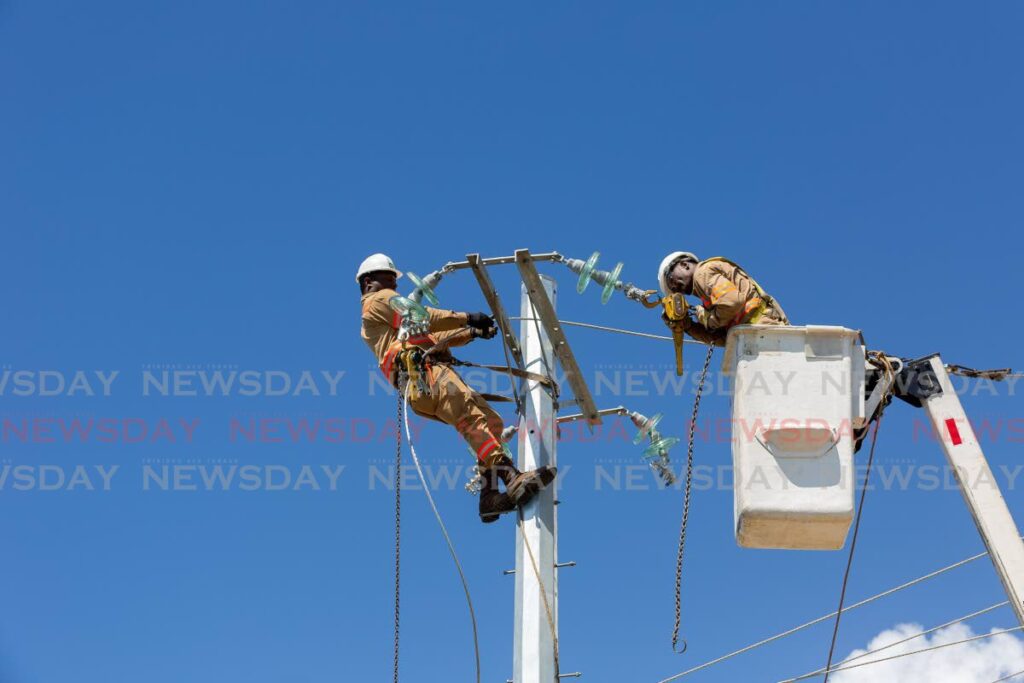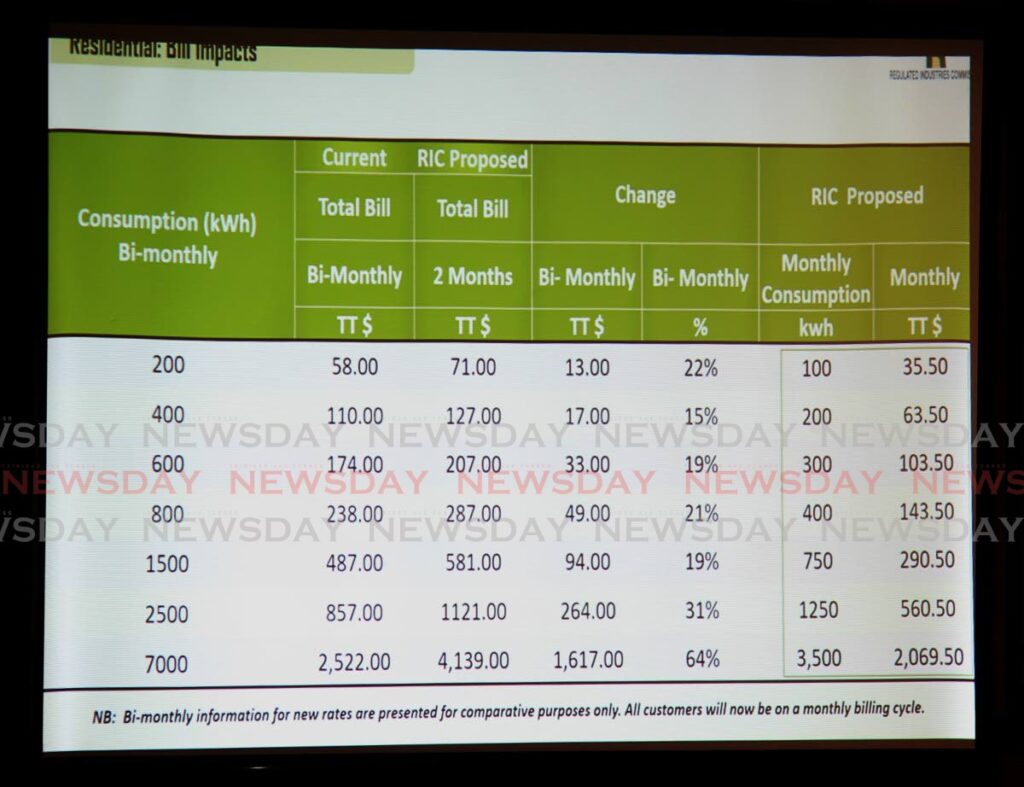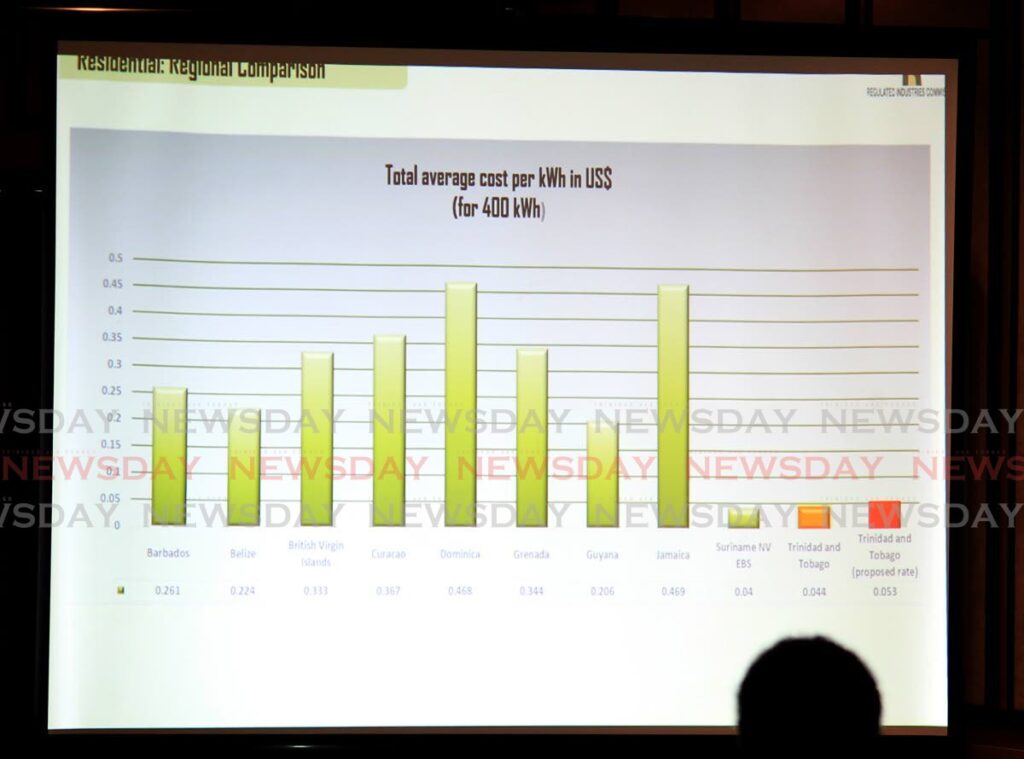PAY MORE FOR POWER – Regulator suggests 15%-64% electricity-rate increase

The Regulated Industries Commission (RIC) has proposed increases in electricity rates of between 15 and 64 per cent, depending on consumption.
The suggested rates were revealed at a media conference held at the Trinidad Hilton in Port of Spain on Thursday.
RIC Chairman Dawn Callendar, in her presentation, said the RIC also proposed three changes to residential rates, including a monthly billing cycle instead of a bill every two months, a widening of the tiers of consumption for payments and the introduction of a fourth consumption tier – higher than 1,400 kilowatt-hours (kWh).
She revealed that the first tier, 0-200 kWh, would have a proposed charge of 28 cents per kWh, tier two, from 200-700 kWh, would have an electricity charge of 40 cents. From 700-1,400 kWh, there would be a charge of 54 cents and greater than 1,400 kWh would have a suggested charge of 68 cents.
It would translate to increases in the electricity bills for residences.
With the current rates, a household consuming 200 kWh for two months would have a $58 bill. With the proposed changes in the charges, that same household would have a $71 bill, a 22 per cent increase.
For the average home which has an estimated usage of 600 kWh according to officials in the RIC, the current rates would mean that the home would have to pay a $174 bill. The proposed changes would increase that bill to $207, a 19 per cent jump.

For residences using 7,000 kWh, the current rates would mean that the household would have a $2,522 bill. With the proposed changes the rates would increase by 64 per cent, to $4,139.
For businesses the rates are even higher. Commercial entities using electricity at a rate of 500 kWh would currently pay $232.50 bi-monthly (every two months). The new rates would bump their charges up by 63 per cent or $147.50, to $380.
If a commercial entity is using 1,500 kWh, it would currently pay $647.50 every two months. That bill will increase by 54 per cent, or $352.50 to $1,000. On the higher end of consumption, about 5,000 kWh, the rates will increase by 51 per cent, from $2,100 to 3,170, a difference of $1,070. For businesses consuming more than 5,000 kWh increases in rates would range between 10 per cent and 11 per cent of the current rates.
Both Callendar and RIC executive director Glenn Khan made it a point to highlight that, despite the increases, TT still has the lowest rates in the region, second only to Suriname.
Khan added the RIC determined its rates based on what they determined was affordable, especially for low-income homes.
“What we did was, one of our engineers looked at appliances in the home including lamps and determined what would be the consumption if someone only had a few items such as two fans, a stove, a fridge, television or radio,” he said.
Callendar said the RIC recognised that with worldwide shocks such as the Russian/Ukrainian war, the pandemic and the resulting increases in the cost of living worldwide adding to financial challenges locally, that it was not the best time for a rate review. But the RIC is mandated by the RIC Act to conduct a review every five years.
“Honestly, there's never a good time to increase prices,” she said. “However, our work is really mandated by our act, and not necessarily international forces or even the local forces.”

She pointed out that there was a long time between the last review and this one. The last time the rates were adjusted was in 2009. She said that one of the main requirements for the review, a submission of a business plan by service provider TTEC, was provided in November 2021 with a deadline of one year to begin reviewing the rates. That period lapsed last month she said.
Khan said the RIC, in its rate review, attempted to balance the needs of three stakeholders – the consumers, the service providers and the Government. He added that for the service providers the increase in rates would ensure improvements in the service while recovering the costs incurred when providing service to the public.
“If I were to raise the rates the public would say this is not good timing. But if we don’t raise rates and TTEC is unable to recover the costs and provide good services over time, the quality of your service will diminish, and therefore what you get would be less than what you desire,” he said.
Khan revealed that TTEC, in its business plan, laid out all its costs in relation to operation and maintenance expenditures over the next five years which amounted to a proposed $29 billion. He said after the RIC analysed the costs, it determined costs at a little over $27 billion.
He told reporters that almost half of TTEC’s expenditure goes into the costs to acquire and convert natural gas, to electricity.
The RIC will engage in nation-wide consultations over the next 12 weeks, to get feedback on the proposed rates, after which a finalised rate will be made and TTEC will, in the subsequent two weeks, inform the public about the final price increases.
Khan noted that although the Government and TTEC were not obligated by law to increase the rates as suggested by the RIC, the rates proposed would be the highest that government could adopt.
Earlier this year, in February, the entire country experienced a blackout. Minister of Public Utilities Marvin Gonzales explained in a subsequent presentation in Parliament that a 21-metre-tall tree fell in onto a single phase TTEC 12 KV distribution line amid a period of high wind and bad weather. The line came into contact with another causing both lines to trip and de-energise
Then in July there was a major power outage experienced in several areas including Curepe, Diego Martin, Penal, Macoya, Malabar, Chin Chin and Piparo. That was owing to an issue with one of the towers which supplies the Union-Ghandi line in south Trinidad.
In November, after another power outage owing to a load-shedding event affected about 16 per cent of TTEC’s customers, Gonzales explained in Parliament that TTEC was minimising the cost of spinning reserves, which he said was a significant cost to TTEC.
Newsday attempted to reach Public Utilities Minister Marvin Gonzales by phone and over WhatsApp; as well as Minister in the Office of the Prime Minister, Symon de Nobriga, but both attempts proved unsuccessful.


Comments
"PAY MORE FOR POWER – Regulator suggests 15%-64% electricity-rate increase"